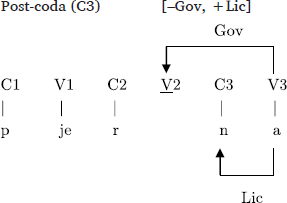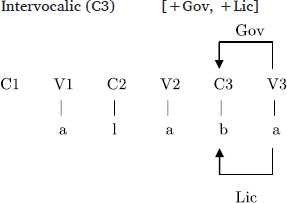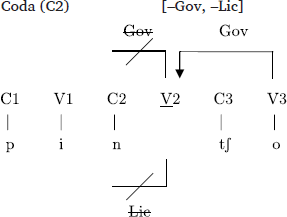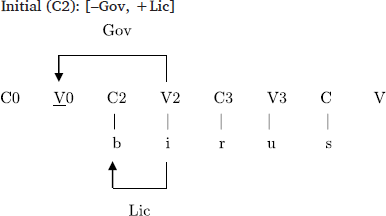1 Introduction
In many Spanish dialects, phonemic /s/ has a debuccalised allophone: [h]. Within the European Iberian Peninsula, this process occurs mostly in the Southern region of Andalusia (incl. various sub-varieties such as Granada, which we will see in this paper). The process is very extensive in Central and South American Spanish varieties, such as those spoken in Argentina (incl. Rio Negro and Buenos Aires) and Chilean (which we also see in this paper). This debuccalised allophone [h] typically occurs word-internally in the coda position, however, it also shows considerable variation at higher prosodic constituents.
The variation in many dialects is purely positional, and this is the focus of the paper. There are also patterns that have additional stress-based conditioning, but these will not be treated here (Lipski 1985). We will also not be dealing with s-debuccalisation in word-initial position, such as New Mexican Spanish, which is very variable, even within particular tokens: cerrar = herrar (25%) (Brown 2005: 820).
This paper will analyse the patterns of (North) Chilean Spanish (Broś 2018) and Rio Negro Argentinian (Harris & Kaisse 1999) compared with the Andalusian of Granada (as described in Colina 1997).1 Finally, the pattern of Buenos Aires Spanish will complete the typology of positional s-debuccalisation.
All of these varieties have the same distribution of [s] and [h] inside monomorphemic items, except that in Chilean Spanish /s/ has an additional process of ‘final deletion’ (1c). The Granada-type and the Chile-type are contrasted with their peninsular counterparts (including Standard Peninsular [θ], which is neutralised with /s/ in the relevant Spanishes).
- (1)
- Word-internal Debuccalisation
- a.
- b.
- c.
- d.
- e.
- f.
- g.
- Granadan
- de[h]de
- ju[h]to
- [s]ol
- ko[s]a
- ten[s]o
- ve[h]
- mucho[h]
- Chilean
- de[h]de
- ju[h]to
- [s]ol
- ko[s]a
- ten[s]o
- ve[Ø]
- mucho[Ø]
- Peninsular (Standard)
- de[z]de
- ju[s]to
- [s]ol
- ko[s]a
- ten[s]o
- ve[θ]
- mucho[s]
- ‘since’
- ‘just’
- ‘sun’
- ‘thing’
- ‘tense’
- ‘instance’
- ‘many’
The core separation in the dialects comes from their treatment of /s/ between the juncture of larger prosodic units, such as the juncture between words and prefixes.
- (2)
- Outside the word
- a.
- Word-juncture
- i. Pre-consonantal
- Granadan
- otro[h]#puerto[h]
- la[h]#normativa[h]
- Chilean2
- otro[Ø]#puerto[Ø]
- la[Ø]#normativa[Ø]
- Peninsular
- otro[s]#puerto[s]
- la[z]#normativa[s]
- ‘other ports’
- ‘the rules’
- ii. Pre-vocalic
- Granadan
- una ve[h]#entré
- uno[h]#echo[h]
- Chilean
- una ve[h]#entré
- uno[h]#echo[Ø]
- Peninsular
- una ve[θ]#entré
- uno[s]#echo[s]
- ‘once entered’
- ‘some events’
- b.
- Prefix-juncture
- i. Pre-consonantal
- Granadan
- de[h]-calzar
- de[h]-confiar
- Chilean
- de[h]-calzar
- de[h]-confiar
- Peninsular
- de[s]-calzar
- de[s]-confiar
- ‘to unshoe’
- ‘to mistrust’
- ii. Pre-vocalic
- Granadan
- de[h]-echo
- de[h]-ilusión
- Chilean
- de[s]-echo
- de[s]-ilusión
- Peninsular
- de[s]-echo
- de[s]-ilusión
- ‘undone’
- ‘to mistrust’
Many different analyses have been proposed to solve the variation s-debuccalisation. So far, no analysis of the phenomenon has been proposed that does not have: (a) extrinsic rule ordering across multiple prosodic levels (Harris & Kaisse 1999), (b) multiple rankings/grammars for different prosodic constituents (Roca 2005; Broś 2018), (c) differentiating prosodic levels (recursive prosodic words etc…) (Wiltshire 2002; 2006), or (d) Output-Output Correspondence (Colina 2002; 2009; Face 2002; McCarthy 2005).3
The analysis I will present is representational and unifies the environment for s-debuccalisation both within and across words, with the only differences being of cyclicity and the representational implications that cyclicity has in the framework I will be presenting. The tools that the analysis use are common to all analyses in the framework of Strict CV (Lowenstamm 1996; Scheer 2004).
2 Some previous accounts
I sketch here Harris & Kaisse’s (1999) analysis of phrase-level s-debuccalisation (as they refer to it, “Aspiration”) in Argentinian Spanish. Their paper considers the variation across Buenos Aires Argentinian (known as Porteño) that differs minimally from Chilean, and the Word-level s-debuccalisation of Río Negro Argentinian, that closely resembles Granadan.
- (3)
- S-debuccalisation (Harris & Kaisse 1999)
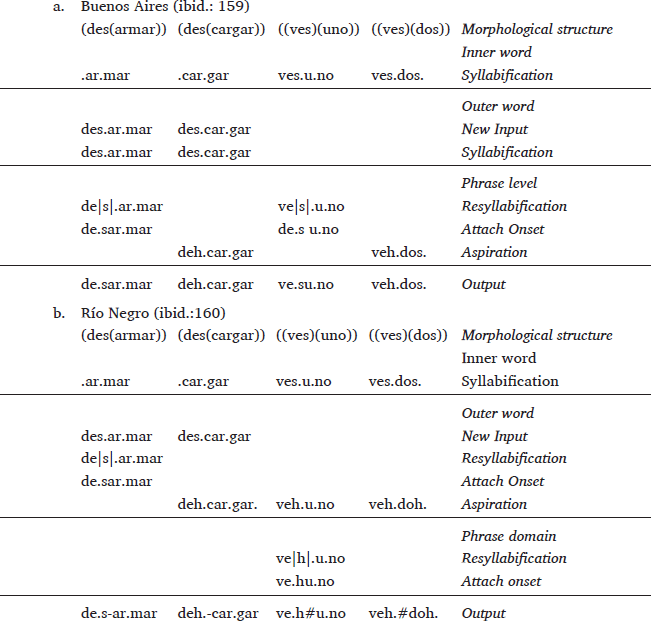
In Buenos Aires (3a), the rules Aspiration and Resyllabification occur at the phrasal domain. Whereas, in Río Negro (as we see in (3b)), Aspiration and Resyllabification are found in the outer word phonology. The opacity is handled by the morphological structure, which prevents the input ((ves)(uno)) from being resyllabified in the outer word layer, later leading to opacity when these rules apply at the phrasal domain.
Taking Chilean and Granadan as her objects of study, Broś (2018) proposes a Stratal OT analysis. It involves two grammars, one at the Word level, and another at the Phrase level. The analysis operates using ordinary markedness constraints *h, *s]Coda, MAX(seg) and, specially, a Contiguity enforcing constraint: CONTIG (Kenstowicz 1994). This constraint operates exclusively within morphemes, resulting in the non-deletion of internal /s/ (with [h] being preferred due to *s]Coda), where CONTIG does not protect the input /s/ segment, deletion will be the more optimal strategy. However, simply re-ranking these constraints cannot account for the dialectal variation, in addition one has to stipulate that the Chilean Word-level is the grammar of the Granadan Phrase-level (Broś 2018: 75–76).
3 The nature of the analysis to come
Before discussing the specific formal mechanisms behind the analysis, I will foreshadow the nature of the phonological analysis in this paper.
The key to understanding the typology of the pattern is to observe that the behaviour of prefixes is variable across different dialects. In Chilean, the /s/ of prefixes has the same behaviour as /s/ word-medially. Whereas, in Granada the /s/ of prefixes has the same behaviour as it does at the juncture of words.
- (4)
- Chilean prefix-juncture and word-internal are identical
- s > h /_.C
- s > Ø / _#
- s / _V
- Prefix-Juncture
- de[h]-calzar
- n/a
- de[s]-echo
- Word-Internal
- de[h]de
- mucho[Ø]
- ko[s]a
- cf.
- s > Ø /_.C
- s > h / _V
- Word-juncture
- otro[Ø] # puerto[Ø]
- uno[h] # echo[Ø]
- (5)
- Granadan prefix-juncture and word-juncture are identical
- s > h /_.C
- s / _V
- Prefix-Juncture
- de[h]-calzar
- de[h]-ilusión
- Word-Juncture
- otro[h] # puerto[h]
- una ve[h] # entre
- cf.
- s > h /_.C
- s > h / _#
- s / _V
- Word-Internal
- ju[h]to
- ve[h]
- ko[s]a
In order to generate this state of affairs, it is possible to state that in some varieties the prefix forms a domain with the word, while in others it does not. Or, put another way, the prefix is either cyclic or it is not. If the prefix is cyclic, its final /s/ will pattern like the /s/ at a word-juncture. Whereas, if the prefix is not cyclic, its final /s/ will pattern like a word-internal /s/.
According to these criteria, the difference in the behaviour of prefixes in Granadan and Chilean Spanish is as follows. The difference between the systems leads to an effective word-boundary between the prefix and stem in Granadan but not in Chilean (6a–b). This leads to the bracketing in (6c).
- (6)
- a.
- Granadan
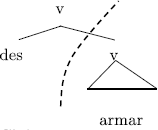
- b.
- Chilean
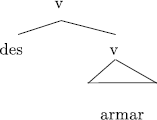
- c.
- d.
- (des-(armar))
- des-CV-armar
- = mi-CV-sal ‘my salt’
- (des-armar)
- des-armar
- unlike mi-CV-sal ‘my salt’4
Following the Strict CV literature, the cyclic or phasal boundary of syntactic heads is marked phonologically through the insertion of an empty piece of skeletal structure, the empty CV (Scheer 2012).5 This empty CV has been motivated in various other studies where its effects can be directly demonstrated (Lahrouchi 2013; 2018; Ben Si Saïd 2020). This is in order to achieve a modular translation between syntax and phonology that respects the desiderata of a generative interface theory: modular and non-diacritic (Scheer 2012: 14).
Scheer’s (2012) innovation was to insist that the syntactic boundary (defined by some syntactic head) is translated into an actual object of the phonological representation (in Strict CV, an empty CV unit). Having the boundary marker be an ordinary piece of phonological representations avoids positing entirely spurious, arbitrary, diacritical boundary marks #, %, &… into the phonology.
If a prefix is cyclic, spell out will introduce a piece of syllable structure (an empty CV unit) into the representation. This inserted CV unit (seen in 6a), disrupts the locality between the prefix and the verb stem, in just the same way as we assume occurs between words. Crucially, unlike a diacritic, this inserted empty CV structure will have to be phonologically computed like any other piece of syllable structure (Scheer 2012). This has led to providing numerous phonological predictions of what external sandhi will look like in different languages (Scheer 2012), and a re-analysis of intransigent bracketing paradoxes (Newell 2021).
As will be demonstrated later, since in this theory the mechanism for debuccalisation is an /s/ preceding an empty V-slot (the phonological context of ‘coda’) and the cyclic boundary mark itself contains an empty V-slot, this account fully unifies the contexts for debuccalisation both within and across-words.
3.1 Getting in front of some objections
Before showing this analysis, I feel it is important to clarify some things which might be troubling some readers. Specifically, that the cyclic nature of prefixes is arbitrary/ad-hoc/unmotivated.
Naturally, it would be handy if this cyclicity could be derived from a more general syntactic fact, that cuts across Spanish dialects, but I am not aware of one. However, I would like those readers in particular to consider the following paragraphs before repudiating this aspect of the analysis.
Firstly, this is formal description of the system, it is not supposed to be the “first cause” of the pattern. I do not suppose that the /s/ began leniting because of the chunking in (6a).
Secondly, the lack of independent motivation for the prefix cycle in (6a) does not make the analysis any more ad-hoc than positing different rules at specific strata (Harris & Kaisse 1999), or different constraint rankings at different prosodic levels (Broś 2018). The question there remains the same: why is this ranking/rule at this level? In fact, since in Broś (2018) the Chilean word-level is the grammar of the Granadan phrase-level, it shows that the explanation cannot be based in the inherent nature of the rules and levels. Just as for Harris & Kaisse (1999), there is no independent reason for delaying Resyllabification and Aspiration rules to the phrase level in Río Negro.
I would even go further and say that the chunking analysis in (6) is even less ad-hoc than these previous approaches because there is only one phonology applied to different chunks, rather than having both different chunks (different bracketing and prosodic levels) and a different phonology for each level.
In fact, I do not think that the inability to derive the chunking from the syntax makes the analysis ad-hoc. Convergent evidence, or deriving the chunking from the syntax are good for supporting the chunking hypothesis presented in (6), but lack of exterior evidence does not invalidate its own evidence available to the learner.
Again, this is not a problem because I am not assuming that the chunking is the “first cause” of the pattern. I assume that a gradient phonetic lenition became categorialised/phonologised as a formal phonological analysis. Naturally, the formal phonological analysis has to fall within the range of possible phonologies.
In this specific case it amounts to saying that the possibility of being cyclic or not is made available by Universal Grammar. Counterfactually, we could have been in a world where all affixes are cyclic (matching the boundaries between words) or none of them ever are (always matching word-internal conditions). However, it is demonstrable that prefixes can exist in either state.
Where this fact is not derivable by some other property, the learner establishes it through the data. This appears to be also how parameters work, since they are also linguistically variable properties that cannot be derived or determined only by UG and are set by the child’s encounter with the data (even if this is mediated by complex internal structure such as parameter hierarchies) (Roberts 2019). In this case, the formal choice would be for heads in the morpho-syntax to be: Cyclic <yes, no>.
If one wanted to continue to think of this analysis as merely a description and not an explanation, they are welcome, but this is not so much a criticism of the analysis, it is merely a difference in the use of the word “explain”, and it applies just as much to the previous analyses.
4 Tools of the Strict CV analysis
Before I show how the Strict CV analysis works, I will present an introduction of the tools of Strict CV for the unfamiliar reader. This will also include detail on the mapping between phonology and phonetics in a feed-forward modular, realisational framework.
The representations of Strict CV are autosegmental and made up two independent tiers linked to each other by association lines (Lowenstamm 1996; Scheer 2004). The top tier is made up of strictly alternating CV units; the lower layer instead is comprised of segmental features. Any underlying form can come in the following variety of shapes. This can include floating features (7b), empty skeletal structure (7c) or both (7d) (Bendjaballah & Haiden 2008; Faust et al. 2018; Lahrouchi & Ulfsbjorninn 2022).
- (7)
- Shapes of exponents

4.1 Silencing empty positions
The presence and the phonetic interpretation of empty skeletal positions is regulated by some universal mechanisms. They were largely developed in the literature for handling featurally empty vowel-zero alternations such as those of Morroccan Arabic (Kaye 1990) and French (Charette 1991). Since then, these conditions have found their application in very many languages, see Scheer (2004) for some of these.
- (8)
- Silencing of empty positions
- a.
- Domain-Final Parameter (DFP) (based on Kaye 1990)
- Domain-final empty V slots are silenced (receive no phonetic interpretation)

- b.
- Gov(ernment) and the Empty Category Principle (ECP) (based on Kaye 1990; Charette 1991)
- An empty V-slot can be silenced by Gov iff it is followed by a V-slot that is not itself silenced by Gov.
- Ungoverned empty V-slots violate the ECP (Kaye et al. 1990).

4.2 Deleting empty skeletal positions
Empty skeletal slots are also subject to a deletion operation called Reduction. This is developed from (Gussmann & Kaye 1993); it removes an empty V-slot followed by an empty C-slot from the representation (see V2-C3 below). This results in a newly formed CV string (C2V3).
- (9)
- Reduction6
- a.
- Input string with hypothetical segments (reduction site shown crossed out)

- b.
- Output

The application of Reduction is cross-linguistically parametric, see Ulfsbjorninn (2022), and crucially, it applies at the Vocabulary Insertion itself. It is not a surface level constraint. Immediately as the phonological string is formed, Reduction either applies or it does not, and the resultant string is fed to the phonology.
4.3 Lateral forces, silencing and strength
These strictly alternating C and V slots enter into two specific lateral relations: Government and Licensing. These relations formally define positional strength in phonology (Ségéral & Scheer 2001; Scheer 2004): Government (Gov) is a weakening force, phonetically inhibitory, while Licensing (Lic) is a strengthening force, associated with the phonetic enhancement of a position. Positions that are Gov’d are weaker for it, and positions that are Lic’d are stronger for it. Filled V-slots can issue both Gov and Lic (shown in (8)). Gov and Lic are issued from V-slots in a right-to-left manner. As shown in (10), Empty V-slots require Gov to remain phonetically uninterpreted (cf. the extension to vowel-zero alternations (Kaye 1990; Charette 1991)), this renders the post-coda position especially strong since this C-slot is Licensed and not Governed: [–Gov, +Lic]. We see this in (10a).
If, however, the V-slot preceding the C is filled (V2), it will not be governed, as such the C-slot (C3) will be weak since it is also Governed: [+Gov, +Lic]. This is shown in (10b).7
Empty V-slots, such as (V2) in (10c), cannot provide either lateral relation. The Coda position is not Governed, but neither is it licensed, and therefore it is weak: [–Gov, –Lic].
As discussed in (§3) above, the string/phase initial position is marked with an empty CV. Being an ordinary piece of skeletal structure (and not merely a diacritic), this initial CV also participates in the lateral relations. Since its V is empty, it will absorb the Gov of a V-slot, consequently rendering the initial C “onset” strong, we see this in (10d).8
- (10)
- Gov and Lic based on Ségéral & Scheer (2001)
- a.
- b.
- c.
- d.
4.4 Strength of medial and final positions
A final distinction that can be made phonologically in terms of V-slots and their potential for lateral relations relates to their position in the string. There is an inherent representational difference between the final empty V-slots “nuclei” (FEN), of which there can only ever be one, and any of the medial empty V-slot “nuclei” (MEN).
The licensing potential of FEN with regard to MEN is variable across different linguistic varieties (Charette 1990; Cyran 2003; Scheer 2012; Faust & Ulfsbjorninn 2018; Balogné Bérces & Ulfsbjorninn 2023).
In Chilean we will see that (optionally) /s/ is completely lost [Ø] before FEN, unless this triggers a hiatus context (*VV) and in these cases the [s] is retained.
We will also see that the FEN in Buenos Aires Spanish is a licensor (just as it is in other varieties not specifically treated in this paper such as Llanito (Ulfsbjorninn 2022)).
5 Debuccalisation, a formal approach
5.1 Lateral forces and Debuccalisation
The process of debuccalisation from a formal phonological perspective seems to be especially connected to the lateral force called Licensing. This is explicitly modelled for the n/ŋ-alternations we see in Galician (Ulfsbjorninn 2020). The way this representational, realisational process occurs is shown here.
The analysis is realisational in the sense that a phonological representation (surface form) is mapped to objects in the phonetic form for implementation. This spell out between phonology and phonetics makes reference to the phonological objects and their lateral relations.
Since there is a feed-forward spell out from phonological objects to phonetic implementation, the analysis here is completely consistent with a phonology-first, phonetics-second linguistic architecture familiar to Substance Free Phonology (Hale & Reiss 2008; Reiss 2017; Volenec & Reiss 2020, see also Scheer 2019; 2022; Chabot 2021).
The way debuccalisation works in this model, referencing lateral forces, is introduced using the case study: the realization of rhotics in Dominican Spanish (for an analysis of this in other Spanish and Portuguese varieties, see De Souza 2018).
The rhotic-realisation of Dominican Spanish follows the lateral forces discussed in (§4.3) very closely. We see a three-way, not a two-way, pattern of rhotic realization. The data comes from Jiménez Sabater (1975: 86–87) and Núñez Cedeño (1987; 1994: 31). The phonetic transcription follows from Willis & Bradley (2008).
- (11)
- Phonetic implementation of rhotics in Dominican Spanish
- a.
- Initial Trill
- i.
- ii.
- [r̥]ie
- [r̥]ubio
- ‘s/he laughs’
- ‘blond’
- b.
- Post-coda Trill
- i.
- mal[r̥]otar
- ‘to waste’
- b.
- Intervocalic Trill
- i.
- ii.
- iii.
- piza[r̥]a
- entie[r̥]o
- bu[r̥]o
- piza[ɦɾ̥/r̥]a
- entie[ɦɾ̥/r̥]o
- bu[ɦɾ̥/r̥]o
- ‘blackboard’
- ‘burial’
- ‘donkey’
- c.
- Intervocalic Tap
- i.
- ii.
- pisa[ɾ̥]a
- bu[ɾ̥]o
- ‘he would step’
- ‘bureau’
- d.
- Pre-consonantal Tap
- i.
- ii.
- iii.
- pe[ɦ]la
- ca[ɦ]ne
- a[ɦ]ma
- ‘pearl’
- ‘meat’
- ‘weapon’
A summary of the pattern is shown in the table beneath.
- (12)
- Realisations of rhotics in Dominican Spanish by context
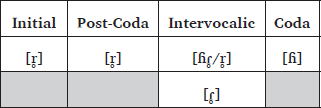
These environments correspond to the following lateral relations, which are converted into the phonology-phonetics interface conditions (spell out) for rhotics. The structures for these positions and the lateral forces operating on them are shown in (13) beneath. In these structures, the single underlying rhotic is shown with the symbol: ®.
- (13)
- Underlying representations and interpretation
- a.
- [kaɾ̥o] ‘dear’
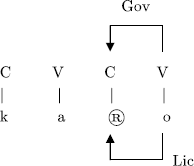
- b.
- [boɦɾ̥/r̥o] ‘erases’
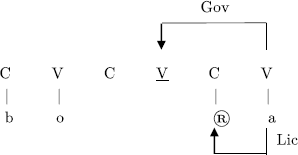
- c.
- [peɦla] ‘pearl’
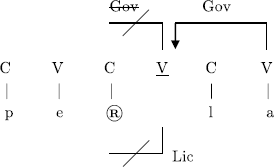
A summary of lateral relations and their outcomes is shown in (14) beneath.
- (14)
- Lateral relation correlations with Dominican Spanish rhotic realisation
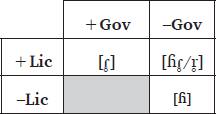
Following these conditions, a tap will be predictably banned from the initial position. This is because, being string initial, it will be preceded by the prefixed empty CV (15a). This inserted empty CV is a regular part of the phonological representation and so it will interact with the lateral relations, thereby converting an “initial r” into a [–Gov +Lic] C-slot (15b), thereby surfacing as a trill.
- (15)
- Initial CV insertion ‘rose’ (De Souza 2018)
- Initial CV + root underlying form

- Computed form: [r̥]osa ‘the rose’
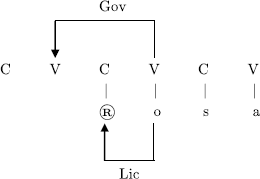
5.2 Lateral forces and phonetic implementation
The specific way in which the lateral forces are being mapped to the phonetic implementation is shown beneath.
- (16)
- Phonology to phonetics spell out
- a.
- Instructions for implementation for ®:
- Active articulators for place of articulation
- Closure cycles (Tap-ness vs. Trill-ness)
- b.
- Spell out conditions for ®

- c.
- Implementation for ®
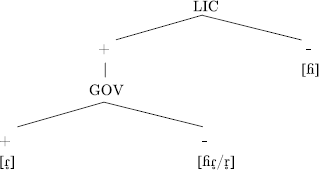
As will now be demonstrated, what is sketched for /r/ in Dominican Spanish (Author) is surprisingly similar to the Strict CV analysis of word-internal /s/ allophony in the s-debuccalising Spanish dialects; except that Chilean has the additional (optional) condition of deletion of /s/ in final position.
6 The Spanish s-debuccalisation typology
We now apply our formal tools to the Spanish debuccalisation typology. We will take these environment by environment starting with word-internal debuccalisation, then passing to other contexts.
6.1 Word-internally
Now we see how word-internal s-debuccalisation operates formally. Recall the pattern for Granada and Chilean Spanish.
- (17)
- Granadan word-internal debuccalisation
- a.
- b.
- c.
- s / _V
- s > h /_.C
- s > h / _#
- ko[s]a, [s]ol
- kal[s]ar
- de[h]de
- mucho[h]
- ‘thing’ ‘sun’
- ‘shoe (v.)’
- ‘since’
- ‘much’

- (18)
- Chilean
- a.
- b.
- c.
- s / _V
- s > h /_.C
- s > Ø / _#
- ko[s]a, [s]ol, kal[s]ar
- de[h]de
- mucho[Ø]
- ‘thing’, ‘sun’, ‘shoe (v.)’
- ‘since’
- ‘much’

In Chilean, the FEN is associated with the complete non-interpretation of /s/ (a.k.a. deletion). Within words, in all the s-debuccalising dialects, we see the following distribution of lateral relations and their phonetic spell.
- (19)
- Lateral relations and spell out of /s/ in debuccalising dialects of Spanish
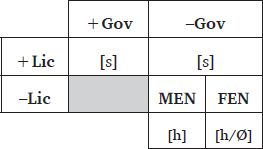
The pattern here shows that the phonetic spell out of the place feature of /s/ seems to be intimately connected to the lateral force of Licensing.
- (20)
- Spanish /s/
- a.
- Cognitive phonetic representation9

- b.
- Spell out conditions for /s/

When the phonetic features of /s/ are being spelled out in preparation for phonetic implementation, the Place node of /s/ is only inserted if the phonological position is +LIC.10
6.2 Spelling out /s/ in higher “constituents”
The spell out conditions listed above are uniform for all s-debuccalising Spanish dialects. They apply non-problematically within words, and they are blocked systematically across words in all varieties, through the insertion of the empty CV discussed in (§3). The point of variation is the insertion of the empty CV at the prefix juncture, that is to say: some prefixes are cyclic and others are not.
This variation is summarised in the table beneath, positions that involve adding an Empty-CV are marked with +CV in the cell.
- (21)
- Contexts and outcomes cross-dialectally

The same outcomes of /s/ are found in word-internal and prefix-junctures in Chilean, whereas in Granadan the prefix-junctures behave like word-junctures. The derivation of these environments is shown beneath.
The differences in the behaviour of the prefixes in Granadan and Chilean are assumed to follow from the presence or absence of a phase/domain-initial CV. This is a sequence of empty syllable structure that is added between prefix and stem in Granadan but not in Chilean.
6.2.1 Granadan prefix
I now come to the analysis of the prefix in Granadan Spanish. The prefix-juncture behaves like the word-juncture with regard to s-debuccalisation. This is taken to result from the cyclicity of the prefix in this dialect.
- (22)
- Granadan

This generates the following representations where the prefix occurs before a consonant-initial stem. Consequently, Reduction occurs at this juncture, as the empty CV disrupts phonological locality between the prefix and the stem. The Reduction site applies at Vocabulary Insertion and is shown greyshaded in the string (23a). We show its removal by reduction in (23b), this is the string fed to phonological computation (23c).
- (23)
- Granadan
- a.
- /des/ + calzar

- b.
- Reduction

- c.
- Computed form: de[h]-calzar

The output of this computation leaves /s/ in (C2), this comes before a Gov’d (word-medial) empty nucleus (V3). Consequently, C2 will be: [–Gov –Lic]. Since /s/ is –Lic, it will be exponed without its place node: [h].
Meanwhile, when the prefix comes before a vowel-initial stem, a similar set of processes occur. Crucially, the insertion of the phase-initial empty CV leads to the prefix and stem being separated by an empty Governed V-slot, even after Reduction has been applied. This leads to the following derivation.
- (24)
- Granadan
- a.
- /des/ + echo

- b.
- Reduction

- c.
- Computed form: de[h]-echo11
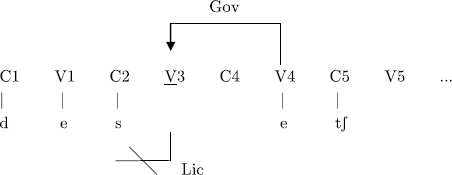
Even after Reduction has applied, /s/ (still in C2) is still followed by a medial empty Gov’d V-slot (V3). Consequently, /s/ will be [–Gov –Lic], exactly as it would be in a coda-position. The fact that the stem is vowel initial (V4), gives the impression of opacity (overapplication) of the s-debuccalisation rule. This is because the surface debuccalised /s/ will be followed by a surface vowel: de[he]cho. Strict CV does not have resyllabification, short of (a) the phonological relinking of floating consonants and (b) the effect caused by phonetic rephrasing of intervocalic consonants, consequently, I attribute the “onset hood” of this lenited /s/ to phonetic phasing (a production effect).
The empty CV is also found between word-junctures where it leads to the same outcome: unos-CV-calamares ‘some squid’. This leads to the same bahaviour of /s/ at the prefix- and the word-juncture.
6.2.2 Chilean prefix
In the Chilean derivation, /des-/ is non-cyclic and, as such, there is no phase-initial empty CV to disrupt locality. This leads to the following phonological representations and their computation.
- (25)
- Chilean

The structure shown in (25) leads to the phonological derivation shown in (26).
Since there is no Initial CV added between the prefix and the stem, the prefixed forms in Chilean are indistinguishable from word-medial ones.
- (26)
- Chilean
- a.
- /des/ + calzar

- b.
- Computed form: de[h]-calzar
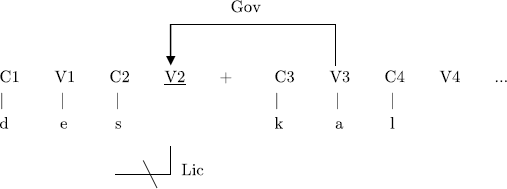
As the derivation in (26) shows, at the end of the computation /s/ is located in (C2) and it is before a medial empty V-slot (V2). Therefore, C2 will be [–Gov –Lic]. Since the /s/ is not Licensed in this position, it will surface as debuccalised (without its place feature: [h]). This is identical to a word-internal coda /s/: a[h]co ‘disgusting’.
In Chilean, the prefix before a prevocalic stem will also not have its locality disrupted. This means that once Reduction has applied, the /s/ in (C2) will be located before a filled V (V3). As such, C2 will be [+Gov +Lic], since it is Licensed, the /s/ will be exponed with place features as a phonetic: [s].
- (27)
- Chilean
- a.
- /des/ + echo

- b.
- Reduction

- c.
- Computed form: de[s]-echo
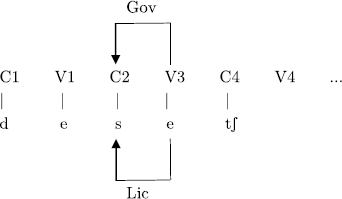
6.3 The word-juncture (in Chilean)
As mentioned previously, in Chilean Spanish there is an extra process of deletion. This occurs to “pre-pausal” /s/ and to pre-consonantal /s/ at the word-juncture: otro[Ø]#puerto[Ø] “other ports”.
In this same context, but before vowels, /s/ is not deleted, instead, it is merely debuccalised to [h]: una#ve[h]#entré ‘once entered’.
The extra step of deletion occurs both in domain-final position and in the context of a pre-consonantal word-juncture. I unify these by equating being domain-final and pre-domain-initial. In these contexts, /s/ unlinks from its C.
Take the UR in (28a), the steps of unlinking and Reduction are simultaneous, I show them separately in (28b and c) for the reader’s convenience. Once these processes have occurred, the string is fed to the phonology. This gives the phonology a string with an unlinked /s/ and there is no phonological motivation to relink it, the computed form is shown in (28d). Unlinked (i.e. deleted) segments are shown greyshaded.
- (28)
- Chilean word-juncture
- a.
- /otros + puertos/

- b.
- Unlinking (Chilean only)

- c.
- Reduction

- d.
- Computed form, /s/ is unlinked without a reason to reattach it
- Surface form: otro[Ø]#puerto[Ø]
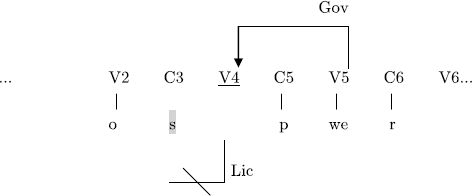
Since this is a feed-forward derivational approach to phonological computations, the /s/’s association line is lost an earlier step and since there is no phonological motivation to relink it, it stays unliked. The opacity here shows the difference between this and surface-oriented phonological approaches.
Crucially, however, when this same word-juncture context comes before a vowel-initial stem, it leads to a different outcome. Precisely because there is a phonological condition that encourages the non-un-linking or re-linking of the word-final /s/: the vocalic hiatus that would ensue from delinking /s/.
- (29)
- Chilean word-juncture
- a.
- / unos +echos/

- b.
- Reduction and s-unlinking (Chilean, optional)

- c.
- s-relinking for Hiatus

- d.
- Computed form: uno[h]-echos (showing a relinked, but unlicensed /s/)
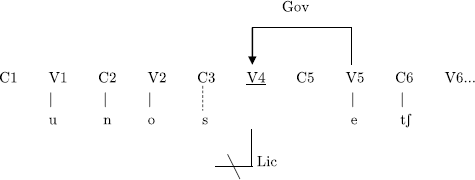
This computation results in a form with a linked /s/, despite its UR (C3) occurring in a pre-phase-initial position (CV4), that would usually entail the unlinking of /s/ (29a).
Unlinking, in this context, however, creates a VV hiatus (Charette 1991), shown greyshaded in (28b). To prevent this, /s/ is relinked to its position (C3) (29d). After the computation and the application of Reduction the /s/ in C3 is still found before an empty Gov’d V-slot (V4). Since this is effectively still a coda-position, the /s/ in C3 finds itself in a [–Gov –Lic] context. As such, it is obliged to surface without phonetic place features: [h]. This outcome is entirely analogous to the Granadan prevocalic prefix-juncture.
6.4 Completing the typology: Argentinian Spanish
The dialects of Argentinian Spanish reported by Harris & Kaisse (1999) are similar to the Chilean presented in Broś (2018). In fact, the dialect of Río Negro appears to be identical to Chilean, except that it does not have the extra deletion rule (unlinking of /s/ in final position).12 The Buenos Aires Spanish, however, shows a much more important difference with Chilean (which it still otherwise resembles).
Buenos Aires possibly completes the positional s-debuccalisation typology since it appears that even its word-junctures are treated like word-internal positions.13
- (30)
- Buenos Aires (Harris & Kaisse 1999: 158)
- s > h /_.C
- s / _V
- s / _#
- ca[h]pa
- de[h]-cargar
- ve[h]#dos
- ka[s]a
- de[s]-armar
- ve[s]#uno
- mucho[s]
- ‘dandruff’
- ‘discharge’
- ‘see two’
- ‘house’
- ‘disarm’
- ‘see one’
- ‘many’
- Word
- Prefix-juncture
- Word-juncture
- Final
6.5 Strict CV analysis
In Buenos Aires, for the purposes of s-debuccalisation, not even word-boundaries are distinguishable from the word-internal position. As such, I propose that there is no initial CV across any boundary in Buenos Aires Spanish. I am not aware of any direct evidence for this claim, however, since its typological pattern is so elegant, it would be interesting to find out whether there is in fact, convergent evidence for this hypothesis. At least, the claim is easily falsifiable.
- (31)
- Cross-dialectally

The derivation of s-debuccalised items will therefore be the same as that of /s/ word-internally and at the prefix-juncture in Chilean (§5.2.2). Additionally, the word-juncture will receive the following derivation.
- (32)
- Word-juncture before a consonant-initial stem (Buenos Aires Spanish)
- a.
- /ves dos/ ‘see two’

- b.
- s [–Gov –Lic] > ve[h]#dos ‘see two’
This means that across the word-juncture and before a vowel-initial stem, there will be Reduction (just as there is across the prefix-juncture). Since no initial CV was inserted at the juncture the /s/ will find itself after the computation in C2 before a filled V-slot (V3). Therefore, C2 will be [+Gov, +Lic]. Consequently, unlike in Granadan, Río Negro or Chilean word-juncture, the /s/ will surface as [s].
- (33)
- Word-juncture before a vowel-initial stem (Buenos Aires Spanish)
- a.
- /ves uno/ ‘see one’

- b.
- Reduction

- c.
- Computed form
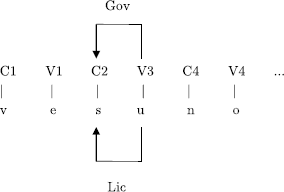
- d.
- s [+Gov, +Lic] > ve[s]#uno ‘see one’
7 Conclusion
This was a fully modular and representational, realisational analysis of s-debuccalisation. The account here models the process not only word-internally, but also across a range of higher “prosodic” domains, including the prefix-juncture and the word-juncture. This was done without using the constituents of the prosodic hierarchy and without using different phonologies at different levels. The key observation is that the prefix juncture behaves either like a word-internal position or a word-juncture in different dialects. Effectively the /s/ of prefixes can be either phase-medial or phase-final (pre-phase-initial). This can be modelled in Strict CV through the insertion of an Empty CV to mark the phase or domain. The prefix in Chilean is effectively word-medial, while in Granadan it is phase-final. This leads to variation in s-debuccalisation and also its perceived opacity. Lastly, Buenos Aires Spanish completes the typology since /s/ at word-junctures behaves identically to /s/ in word-medial position and in prefixes, indicating that when it comes to s-debuccalisation at least, all its junctures look like word-medial positions. Though the analysis does suffer from a lack of independent evidence for prefix cyclicity, the analysis as a whole is also very easily falsifiable. One significant achievement of the analysis, which is specific to the Strict CV framework is that in all the forms, the context for s-debuccalisation is identical:/s/ in an unlicensed position, this environment defines not only the ‘coda’ but also the cycle boundaries.
Notes
- For a comprehensive dialectal survey see Kaisse (1999). See the original sources for more precise empirical picture, particularly with regard to percentages of production, we consider debuccalisation here to be categorical. [^]
- Figueroa (2020 p.c) upholds the data reported in Broś (2018) but adds that deletion is an optional process. This context can also present debuccalisation rather than deletion, preferentially: otro[h]puerto[Ø] but even: otro[h]puerto[h]. This is interesting because formally speaking, deletion is a purely “extra” process to that otherwise expected lenition. [^]
- There is also the elegant account in Torres-Tamarit (2012; 2014), which however appears unable to handle the Chilean deletion pattern (Broś 2018: 73). [^]
- A reviewer, proposes an alternative which is to assume that in the relevant dialects des- itself is lexically marked with an underlying empty CV unit. This could account for the data the same way, and I leave it to their future research to pursue this theoretical option. It is attractive because it frees the analysis from the obligation of seeking a syntactic match for the cyclicity. However, I have not opted for it because (a) prefix cyclicity is not usually syntactically motivated, it is stated just as it is here, and (b) this approach uses two different sources for the extra empty CV unit, whereas the current analysis puts everything down to mappings between syntactic cyclicity and phonological form. [^]
- Scheer (2012) developed Lowenstamm (1999)’s idea that phonological strings always begun with an empty CV, into a framework of the syntax-phonology interface. The insertion of empty CV’s is dependent on the language’s spell out conditions. [^]
- The C and V slots are numbered purely for the reader’s convenience. [^]
- Readers familiar with Strict CV will know that Scheer & Ziková (2010) provide an update of Strict CV lateral relations (Coda Mirror 2.0), however, I use the original system Ségéral & Scheer (2001) (cf. Balogné Bérces & Honeybone 2012). [^]
- Governed V-slots will be shown as underlined: V. [^]
- This is shown in Element Theory (Harris & Lindsey 1995; Backley 2011) where |H| stands for aperiodic energy and |R| stands for the spectral modulations associated with coronality. For the purposes of this paper, any feature system would work as well. [^]
- This underlying indeterminacy is shown with a dotted line in (15a), the association line will only form under Licensing. [^]
- A Reviewer also suggests an interesting alternative that in place of the inserted extra empty CV, there could be a condition that Gov cannot apply across phasal boundaries. I think this is an idea worth pursuing, however, we have opted to continue the idea of merely marking the phasal boundary with an initial CV, since there are many instances of this in the literature (Scheer 2012; Newell 2021). However, I raise this possibility made aware to me by the reviewer as a tantalising possibility. [^]
- Recall that even in Chilean this is somewhat optional see Footnote 2. [^]
- The final strength of /s/ is not obviously explained in this model, though FEN are typologically stronger than MEN (Charette 1990; Cyran 2003; Scheer 2012; Ulfsbjorninn 2017; Faust & Ulfsbjorninn 2018; Balogné Bérces & Ulfsbjorninn 2023), so it is not that out of step with the model. [^]
Acknowledgements
I would like to thank the handling editor Björn Köhnlein and three anonymous reviewers for comments that greatly improved the manuscript. Thanks also to Noam Faust, Heather Newell, Charles Reiss and Tobias Scheer for helpful comments/suggestions. Thanks also to Mauricio A. Figueroa Candia for discussing the Chilean data with me.
Competing interests
The author has no competing interests to declare.
References
Balogné Bérces, Katalin & Honeybone, Patrick. 2012. Splitting “Intervocalic”: expanding the typology of lenition environments. Acta Linguistica Hungarica 59. 27–48. DOI: http://doi.org/10.1556/ALing.59.2012.1-2.2
Balogné Bérces, Katalin & Ulfsbjorninn, Shanti. 2023. Prevocalic Tenseness in English, Binarity and the Typology of Long Vowel Distributions. In Breit, Florian & Youngberg, Connor & Yuko Yoshida (eds.), Elements, Government and Licensing, 77–88. London: UCL Press. DOI: http://doi.org/10.2307/jj.332955.14
Ben Si Saïd, Samir. 2020. La voyelle initiale des noms et l’état d’annexion en kabyle (berbère). Canadian Journal of Linguistics/Revue Canadienne De Linguistique 65(2). 155–180. DOI: http://doi.org/10.1017/cnj.2020.3
Bendjaballah, Sabrina & Haiden, Martin. 2008. A Typology of Emptiness in Templates. In Jutta Hartmann, Veronika Hegedüs & van Riemsdijk, Henk (eds.), Sounds of Silence: Empty Elements in Syntax and Phonology, 2–59. Oxford, Amsterdam: Elsevier.
Broś, Karolina. 2018. Contiguity in Prosodic Words: Evidence from Spanish. Poznań Studies in Contemporary Linguistics 54(1). 37–82. DOI: http://doi.org/10.1515/psicl-2018-0002
Brown, Esther. 2005. New Mexican Spanish: Insight into the variable reduction of ‘la ehe inihial’ (/s-/). Hispania 88(4). 813–824. DOI: http://doi.org/10.2307/20063211
Chabot, Alexander. 2021. Possible and impossible languages: Naturalness, third factors, and Substance-Free Phonology in the light of crazy rules. Nice: University of Côte D’Azure. (Doctoral dissertation.)
Charette, Monik. 1990. Licence to govern. Phonology Yearbook 7. 233–253. DOI: http://doi.org/10.1017/S0952675700001196
Charette, Monik. 1991. Conditions on Phonological Government. Cambridge: CUP. DOI: http://doi.org/10.1017/CBO9780511554339
Colina, Sonia. 1997. Identity constraints and Spanish resyllabification. Lingua 103. 1–23. DOI: http://doi.org/10.1016/S0024-3841(97)00011-9
Colina, Sonia. 2002. Interdialectal variation in /s/ aspiration: The role of prosodic structure and output-to-output constraints. In Lee, James F. & Geeslin, Kimberly L. & Clements, J. Clancy (eds.), Structure, meaning and acquisition in Spanish: Papers from the 4th Hispanic Linguistics Symposium (HLS), 230–243. Somerville, MA: Cascadilla Press.
Colina, Sonia. 2009. Spanish phonology: A syllabic perspective. Georgetown: Georgetown University Press.
Cyran, Eugeniusz. 2003. Complexity scales and licensing strength in phonology. Berlin: Mouton de Gruyter.
De Souza, Andréia. 2018. There is only one rhotic phoneme in Portuguese, Spanish and Catalan: a coda mirror consonant analysis in CVCV phonology. (ms.) Lingbuzz/007927
Face, Timothy. 2002. Re-examining Spanish ‘resyllabification’. In Cresti, D. & Satterfield, T. & Tortora, C. M. (eds.), Current issues in Romance languages, 81–94. Philadelphia: John Benjamins Publishing Company. DOI: http://doi.org/10.1075/cilt.220.07fac
Faust, Noam., Lampitelli, Nicola & Shanti Ulfsbjorninn. 2018. Articles of Italian unite: Italian definite articles without allomorphy. Canadian Journal of Linguistics 63(3). 1–27. DOI: http://doi.org/10.1017/cnj.2018.8
Faust, Noam & Shanti Ulfsbjorninn. 2018. Arabic stress without moras, extrametricality or syllables. The Linguistic Review 35(4). 561–600. DOI: http://doi.org/10.1515/tlr-2018-2001
Gussmann, Edmund & Kaye, Jonathan. 1993. Polish notes from a Dubrovnik Café I: The Yers. SOAS Working Papers in Linguistics and Phonetics 3. 427–462.
Hale, Mark & Reiss, Charles. 2008. The Phonological Enterprise. Oxford & New York: Oxford University Press. DOI: http://doi.org/10.1093/oso/9780199533961.001.0001
Harris, James & Kaisse, Ellen. 1999. Palatal vowels, glides and obstruents in Argentinian Spanish. Phonology 16. 117–190. DOI: http://doi.org/10.1017/S0952675799003735
Kaisse, Ellen. 1999. Resyllabification precedes all segmental rules: Evidence from Argentinian Spanish. In Bullock, A. B. E. & Reed, L. A. (eds.), Formal perspectives on Romance Linguistics: Selected papers from the 28th Linguistic Symposium on Romance Languages (LSRL), 197–210. Amsterdam and Philadelphia: John Benjamins Publishing Company. DOI: http://doi.org/10.1075/cilt.185.15kai
Kaye, Jonathan. 1990. ‘Coda’-licensing. Phonology 7(2). 301–330. DOI: http://doi.org/10.1017/S0952675700001214
Kaye, Jonathan, Lowenstamm, Jean & Vergnaud, Jean-Roger. 1990. Constituent structure and government in phonology. Phonology 7(1). 193–231. DOI: http://doi.org/10.1017/S0952675700001184
Kenstowicz, Michael. 1994. Syllabification in Chukchee: A constraints-based analysis. Proceedings of the Formal Linguistics Society of the Midwest, 160–181. Iowa City: Department of Linguistics, University of Iowa.
Lahrouchi, Mohamed. 2013. Templates, markers and syntactic structure in Tashlhiyt Berber. Lingua 133. 53–72. DOI: http://doi.org/10.1016/j.lingua.2013.03.007
Lahrouchi, Mohamed. 2018. The left edge of the word in the Berber derivational morphology. Glossa: a journal of general linguistics, 3(1). 1–25. DOI: http://doi.org/10.5334/gjgl.250
Lahrouchi, Mohamed & Ulfsbjorninn, Shanti. 2022. Nasal assimilation counterfeeding and allomorphy in Haitian: Nothing Is still something. Linguistic Inquiry, aop, 2022. DOI: http://doi.org/10.1162/ling_a_00469
Lowenstamm, Jean. 1996. CV as the only syllable type. In Current Trends in Phonology Models and Methods. In Durand, Jacques & Laks, Bernard (eds.), 419–442. Salford: ESRI.
Lowenstamm, Jean. 1999. The beginning of the word. In Rennison, John & Kühnhammer, Klaus (eds.), Phonologica 1996. 153–166. The Hague: Holland Academic Graphics.
McCarthy, John Joseph. 2005. Optimal paradigms. In Downing, Laura & Hall, Alan & Raffelsiefen, Renate (eds.), Paradigms in phonological theory, 170–210. Oxford: Oxford University Press. DOI: http://doi.org/10.1093/acprof:oso/9780199267712.003.0008
Newell, Heather. 2021. Bracketing Paradoxes resolved. The Linguistic Review 38(3). 443–482. DOI: http://doi.org/10.1515/tlr-2021-2072
Reiss, Charles. 2017. Substance Free Phonology. In Hannahs, S. J. & Bosch, Anna (eds.), The Routledge Handbook of Phonological Theory. New York: Routledge. DOI: http://doi.org/10.4324/9781315675428-15
Roca, Iggy. 2005. Strata, yes; structure preservation, no: Evidence from Spanish. In Geerts, T. & van Ginneken, I. & Jacobs, H. (eds.), Romance languages and linguistic theory 2003: Selected papers from Going Romance 2003, 197–218. Amsterdam and Philadelphia: John Benjamins Publishing Company. DOI: http://doi.org/10.1075/cilt.270.12roc
Scheer, Tobias. 2004. A lateral theory of phonology. Vol 1: What is CVCV, and why should it be? Berlin: Mouton de Gruyter. DOI: http://doi.org/10.1515/9783110908336
Scheer, Tobias. 2012. Direct interface and one-channel translation. Vol. 2 of A lateral theory of phonology. Berlin: Mouton de Gruyter. DOI: http://doi.org/10.1515/9781614511113
Scheer, Tobias. 2019. Phonetic arbitrariness: a cartography. Phonological Studies (Japan) 22. 105–118.
Scheer, Tobias. 2022. 3 x Phonology. Canadian Journal of Linguistics 67(4). 444–499. DOI: http://doi.org/10.1017/cnj.2022.22
Scheer, Tobias & Ziková, Marketa. 2010. The Havlík pattern and directional lower: Formal approaches to Slavic linguistics. In Zec, Draga & Browne, Wayles (eds.), The Second Cornell Meeting 2009, 471–486. Ann Arbor: Michigan Slavic Publications.
Ségéral, Philippe & Scheer, Tobias. 2001. La Coda-Miroir. Bulletin de la Société de Linguistique de Paris 96. 107–152. DOI: http://doi.org/10.2143/BSL.96.1.503739
Torres-Tamarit, Francesc. 2012. Syllabification and opacity in harmonic serialism. Barcelona: Universitat Autónoma de Barcelona. (Doctoral dissertaion).
Torres-Tamarit, Francesc. 2014. Phonology-morphology opacity in harmonic serialism: The case of /s/ aspiration in Spanish. In Côté, Marie-Hélène & Mathieu, Éric (eds.), Variation within and across Romance languages: Selected papers from the 41st Linguistic Symposium on Romance Languages (LSRL), 39–62. Amsterdam and Philadelphia: John Benjamins Publishing Company. DOI: http://doi.org/10.1075/cilt.333.05tor
Ulfsbjorninn, Shanti. 2017. Formalising the markedness of syllable structure. In Samuels, Bridget (ed.), Beyond Markedness in Formal Phonology, 153–190. Amsterdam: John Benjamins Publishing Company. DOI: http://doi.org/10.1075/la.241.07ulf
Ulfsbjorninn, Shanti. 2020. Segment–zero alternations in Galician definite article allomorphy floating consonants at the left-edge of morphemes. Acta Linguistica Academica 67(1). 1–16. DOI: http://doi.org/10.1556/2062.2020.00011
Ulfsbjorninn, Shanti. 2022. Pseudo-Allomorphy of articles and articulated prepositions in Llanito (Gibraltar). Linx 84. (Available at: https://ling.auf.net/lingbuzz/006961). DOI: http://doi.org/10.4000/linx.8968
Volenec, Volenec & Reiss, Charles. 2020. Formal generative phonology. Radical: A Journal of Phonology 2. 1–148.
Wiltshire, Caroline. 2002. Variation in Spanish aspiration and prosodic boundary constraints. In Satterfield, Teresa & Tortora, Cristina & Diana Cresti (eds.), Current issues in Romance languages: Selected papers from the 29th Linguistic Symposium on Romance Languages (LSRL), 375–389. Amsterdam and Philadelphia: John Benjamins Publishing Company. DOI: http://doi.org/10.1075/cilt.220.25wil
Wiltshire, Caroline. 2006. Prefix boundaries in Spanish varieties: A non-derivational OT account. In Colina, Sonia & Martínez-Gil, Fernando (eds.), Optimality-Theoretic studies in Spanish phonology, 358–377. Amsterdam and Philadelphia: John Benjamins Publishing Company. DOI: http://doi.org/10.1075/la.99.14wil

